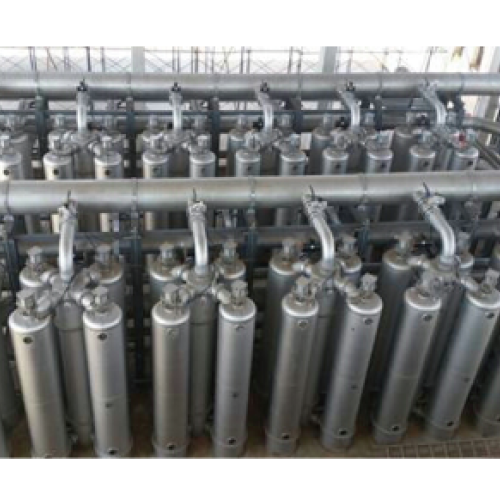SELLING OFFER
Seek co-innovation with global enterprises and governmental institutions
3MINS microfibre filtration
154 2023. 7. 20.
Summary
Established in 1999, a Korea-based sustainable water treatment company invented the first & finest microfibre filtration technology in the world. The innovative water treatment solution, 3MINS WTP—smaller, faster, affordable and sustainable—, has an optimal water treatment efficiency. It purifies water to a drinkable standard in 3 minutes. The company is open to having partnerships with public and private sectors for DWTP(Drinking Water), STP (Sewage) and RO PTP(Desalination) projects.
*DWTP: Drinking Water Treatment Plant
*STP: Sewage Treatment Plant
*RO PTP: Reverse Osmosis Pre-Treatment Plant
Advantages and Innovations
'SMALLER, FASTER, AFFORDABLE AND SUSTAINABLE'.
The 3MINS WTP has an optimal water treatment efficiency that purifies water to a drinkable standard in a mere 3 minutes. Compared with Rapid Sand Filtration (RSF) system, The retention time and the volume is 1/100, the construction period is 1/5, and the cost of construction and operation is 1/3. However, the water quality from our fibre filter and the sand filter are equal, with an NTU of < 0.1 and a removal rate (for 5μm particle) of over 99.99%.
Along with energy efficiency improvement technology, it is not just a lot more ‘Space-economical’ and ‘Cost & Energy-efficient’, but also ‘Sustainable’. As a company pursuing carbon neutrality, our filtration system can reduce carbon emissions by up to 66.6% (2/3) when it is operating compared to other systems on the market.
The filtration system also recycles water for agricultural, industrial usage which is a sustainable way to solve the water shortage in today's world. They have installed 20+ re-use water facilities, for instance in Gimpo Airport Sky Park (Seoul's secondary airport). Also, the technology requires only instant coagulation (1s) unlike conventional coagulation and flocculation. As a result, this filtration system uses less coagulant (1/3), making the drinking water safer.
Lastly, Water quality is ensured at all times through automatic backwash by pressure gauge and timer L/S. CCTV monitoring, The PLC (Programmable Logic Controller), HMI (Human-Machine Interface) and internet connection allows us to remotely control the overseas site no matter where it is. They are enhancing our technology by integrating an AI-powered full automation system.
Stage of Development
Description
⦁ Filter Type
There are two types of filtration devices:
- Pore Control Fibre (PCF) filters by pressure
- Gravity Flow Fibre Filter (GFF) filters by gravity.
⦁ Filtration Process
The PCF filtration system consists of a perforated cylindrical strainer surrounded by flexible fibre bundles. Unlike traditional sand filtration, it does not need flocculation nor sedimentation, but instant coagulation* (1sec), then direct microfibre filtration (3min). During filtration process, the fibres are tightened upward, compressing the air gap. As a result, this removes impurities and suspended solids (SS) through narrow pores* and 15cm deep-pressure filtration. During the backwashing process, the fibres are loosened to make wider pores that enable water and air to vigorously shake off and eliminate SS. This process takes a short time and requires only 5% of raw water.
*Coagulation: Coagulation is a chemical process in which a chemical compound, a 'coagulant', is added to the water to destabilise the suspended particles and promote the creation of flocs.
*Pores: air gaps between particles
The GFF filtration system is similar in principle to the PCF system but relies on gravity. It utilises a 30cm water level difference and a 1cm compressed microfibre layer filter, requiring no additional filtering power beyond gravity. Filtered water flows into backwashing water, eliminating the need for a pump and reducing power costs. Additionally, the use of lighter fibres with a shorter filtration depth than sand filter can further reduce backwashing costs.
⦁ Application
1) Wastewater / Sewage Treatment Plant (WWTP/ STP)
The system is effective in removing SS, BOD and T-P from sewage and wastewater. It is especially useful for treating sewage water for reuse purposes. Compared with Dissolved Air Flotation (DAF) wastewater treatment, Hydraulic Residence Time (HRT) is 1/8, The amount of coagulant is 1/3 and the HRT of the accelerator sedimentation basin is 1/6.
2) Tap Water Treatment Plant (DWTP)
Compared with Rapid Sand Filtration (RSF) system, Hydraulic Residence Time (HRT) is 1/60, Construction and operating cost are below 1/3, but it can remove turbidity up to 99.9% (300 → 0.3 NTU). Further, this system can treat less than 0.1 NTU with 1 NTU sedimentation water. So this system can be an efficient alternative to RSF.
3) Pretreatment of Reverse Osmosis Plant for Desalination (RO PTP)
This system is used for pretreatment in Reverse Osmosis Plants. Compared with Ultrafiltration (UF) and Dual Media Filter (DMF), Hydraulic Residence Time (HRT) is 1/12, but it can remove turbidity up to 0.1 NTU. Furthermore, the lifetime of fibre filtration media is longer, and the replacement cost is lower.
*SS: Suspended Solids. The dry-weight of suspended particles that are not dissolved in a sample of water that can be trapped by a filter that is analysed using a filtration apparatus.
*BOD: Biochemical Oxygen Demand. BOD is an analytical parameter representing the amount of dissolved oxygen consumed by aerobic bacteria growing on the organic material present in a water sample at a specific temperature over a specific time period.
*T-P: Total Phosphorus. T-P is a measure of the total amount of phosphorus in water, including
both organic and inorganic forms.
Technology Keywords
Market Application Keywords
Sector Group
Type and Size of Client
Type and Role of Partner Sought
The company would like to have a partnership with both public and private sectors of existing water companies or a public project with municipalities, an individual company or factory for Drinking Water Treatment Plant (DWTP), Sewage Treatment Plant (STP) and Reverse Osmosis Pre-Treatment Plant (RO PTP), which would include engineering, construction, supply, delivery, installation, testing and pilot. However, the company would also be open to technical aid with their fibre filtration technology and research cooperation.
Type of Partnership Considered
Company
Internal Reference
Category
Files(Download)
If interested, please press this button.
We will answer you soon.